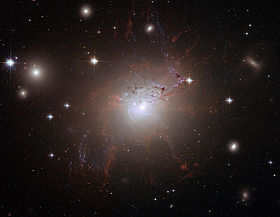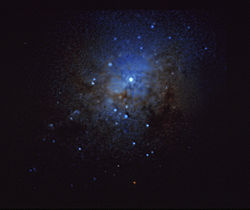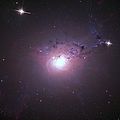- NGC 1275
-
NGC 1275 
Hubble Space Telescope image of NGC 1275Observation data (J2000 epoch) Constellation Perseus Right ascension 03h 19m 48.1s[1] Declination +41° 30′ 42″[1] Redshift 5264 ± 11 km/s[1]
z=0.017559[1]Distance 237 million light-years
72.7 Mpc[2]Type cD;pec;NLRG[1] Apparent dimensions (V) 2′.2 × 1′.7[1] Apparent magnitude (V) 12.6[1] Other designations Perseus A,[1] PGC 12429,[1] UGC 2669,[1] QSO B0316+413, Caldwell 24 See also: Galaxy, List of galaxies NGC 1275 (also known as Perseus A or Caldwell 24) is a type 1.5 Seyfert galaxy[3] located around 237 million light-years away[2] in the direction of the constellation Perseus. NGC 1275 corresponds to the radio galaxy Perseus A and is situated near the centre of the large Perseus Cluster of galaxies. It is morphologically a type-cD galaxy.
Contents
Dynamics
NGC 1275 consists of two galaxies, the central CD Galaxy in the Perseus Cluster, and the so-called "high velocity system" (HVS) which lies in front of it. The HVS is moving at 3000 km/s[4] towards the dominant system, and is believed to be merging with the Perseus Cluster. The HVS is not affecting the CD Galaxy as it lies at least 200 thousand light years from it.[5] The central cluster galaxy contains a massive network of spectral line emitting filaments,[6] which appear to be being dragged out by rising bubbles of relativistic plasma generated by the central active galactic nucleus.[7] Long gaseous filaments made up of threads of gas stretch out beyond the galaxy, into the multimillion-degree, X-ray–emitting gas that fills the cluster. The amount of gas contained in a typical thread is approximately one million times the mass of our own Sun. They are only 200 light-years wide, are often very straight, and extend for up to 20,000 light-years.[8]
The existence of the filaments poses a problem. As they are much cooler than the surrounding intergalactic cloud, how have they persisted for perhaps 100 million years? Why haven’t they warmed, dissipated or collapsed to form stars?[9][10] One possibility is that weak magnetic fields (about one-ten-thousandth the strength of Earth’s field) exert enough force on the ions within the threads to keep them together.[9][10]
Gallery
-

NGC 1275 multi-wavelength composite
References
- ^ a b c d e f g h i j "NASA/IPAC Extragalactic Database". Results for NGC 1275. http://nedwww.ipac.caltech.edu/cgi-bin/nph-objsearch?objname=NGC+1275&img_stamp=yes&extend=no. Retrieved 2006-11-19.
- ^ a b "Distance Results for NGC 1275". NASA/IPAC Extragalactic Database. http://nedwww.ipac.caltech.edu/cgi-bin/nDistance?name=NGC+1275. Retrieved 2010-03-31.
- ^ Ho, Luis C.; Filippenko, Alex V.; Sargent, Wallace L. W. (October 1997). "A Search for "Dwarf" Seyfert Nuclei. III. Spectroscopic Parameters and Properties of the Host Galaxies". Astrophysical Journal Supplement 112 (2): 315–390. arXiv:astro-ph/9704107. Bibcode 1997ApJS..112..315H. doi:10.1086/313041
- ^ Minkowski R., 1957, in IAU Symp 4, Radio astronomy, p107
- ^ Gillmon K., Sanders J.S., Fabian A.C., An X-ray absorption analysis of the high-velocity system in NGC 1275, 2004, MNRAS, 348, 159
- ^ Lynds R., Improved Photographs of the NGC1275 Phenomenon, 1970, ApJ, 159, L151
- ^ Hatch N.A., Crawford C.S., Johnstone R.M., Fabian A.C.: On the origin and excitation of the extended nebula surrounding NGC1275, 2006, MNRAS, 367, 433
- ^ Hubble Sees Magnetic Monster in Erupting Galaxy Newswise, Retrieved on August 21, 2008.
- ^ a b A. C. Fabian, et al. (2008-08-21). "Magnetic support of the optical emission line filaments in NGC 1275". Nature 454 (7207): 968–970. Bibcode 2008Natur.454..968F. doi:10.1038/nature07169. PMID 18719583. http://www.nature.com/nature/journal/v454/n7207/abs/nature07169.html.
- ^ a b Chang, Kenneth (2008-08-21). "Hubble Images Solve Galactic Filament Mystery". The New York Times. http://www.nytimes.com/2008/08/26/science/space/26galaxy.html.
External links
- NGC 1275 on WikiSky: DSS2, SDSS, GALEX, IRAS, Hydrogen α, X-Ray, Astrophoto, Sky Map, Articles and images
- APOD (2003-05-05) – NASA image & description
- APOD (2005-07-25) – NASA image showing unusual gas filaments
- Fabian, A.C., et al. "A deep Chandra observation of the Perseus cluster: shocks and ripples". Monthly Notices of the Royal Astronomical Society. Vol. 344 (2003): L43 (arXiv:astro-ph/0306036v2).
- Fabian, A.C. Nature 454, 968-970.
- Gabany, R. Jay. cosmotography.com – An image made with a 20" telescope, which displays the unusual gas filaments
Coordinates:
 03h 19m 48.1s, +41° 30′ 42″
03h 19m 48.1s, +41° 30′ 42″The Caldwell catalogue List C1 · C2 · C3 · C4 · C5 · C6 · C7 · C8 · C9 · C10 · C11 · C12 · C13 · C14 · C15 · C16 · C17 · C18 · C19 · C20 · C21 · C22 · C23 · C24 · C25 · C26 · C27 · C28 · C29 · C30 · C31 · C32 · C33 · C34 · C35 · C36 · C37 · C38 · C39 · C40 · C41 · C42 · C43 · C44 · C45 · C46 · C47 · C48 · C49 · C50 · C51 · C52 · C53 · C54 · C55 · C56 · C57 · C58 · C59 · C60 · C61 · C62 · C63 · C64 · C65 · C66 · C67 · C68 · C69 · C70 · C71 · C72 · C73 · C74 · C75 · C76 · C77 · C78 · C79 · C80 · C81 · C82 · C83 · C84 · C85 · C86 · C87 · C88 · C89 · C90 · C91 · C92 · C93 · C94 · C95 · C96 · C97 · C98 · C99 · C100 · C101 · C102 · C103 · C104 · C105 · C106 · C107 · C108 · C109See also Categories:- Peculiar galaxies
- Interacting galaxies
- Seyfert galaxies
- Starburst galaxies
- Radio galaxies
- Perseus constellation
- NGC objects
- UGC objects
- PGC objects
- 3C objects
- Perseus Cluster
- Caldwell objects
-
Wikimedia Foundation. 2010.


